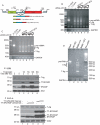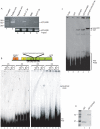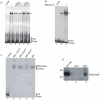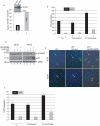Regulation of human neurotropic JC virus replication by alternative splicing factor SF2/ASF in glial cells
- PMID: 21297941
- PMCID: PMC3031499
- DOI: 10.1371/journal.pone.0014630
Regulation of human neurotropic JC virus replication by alternative splicing factor SF2/ASF in glial cells
Abstract
Background: The human neurotropic virus, JC virus (JCV), is the etiologic agent of the fatal demyelinating disease of the central nervous system, Progressive Multifocal Leukoencephalopathy (PML) that is seen primarily in immunodeficient individuals. Productive infection of JCV occurs only in glial cells, and this restriction is, to a great extent, due to the activation of the viral promoter that has cell type-specific characteristics. Earlier studies led to the hypothesis that glial-specific activation of the JCV promoter is mediated through positive and negative transcription factors that control reactivation of the JCV genome under normal physiological conditions and suppress its activation in non-glial cells.
Methodology/principal findings: Using a variety of virological and molecular biological approaches, we demonstrate that the alternative splicing factor SF2/ASF has the capacity to exert a negative effect on transcription of the JCV promoter in glial cells through direct association with a specific DNA sequence within the viral enhancer/promoter region. Our results show that down-regulation of SF2/ASF in fetal and adult glial cells increases the level of JCV gene expression and its replication indicating that negative regulation of the JCV promoter by SF2/ASF may control reactivation of JCV replication in brain.
Conclusions/significance: Our results establish a new regulatory role for SF2/ASF in controlling gene expression at the transcriptional level.
Conflict of interest statement
Figures







Similar articles
-
SF2/ASF binding region within JC virus NCCR limits early gene transcription in glial cells.Virol J. 2013 May 14;10:147. doi: 10.1186/1743-422X-10-147. Virol J. 2013. PMID: 23672192 Free PMC article.
-
JC polyomavirus expression and bell-shaped regulation of its SF2/ASF suppressor during the follow-up of multiple sclerosis patients treated with natalizumab.J Neurovirol. 2017 Apr;23(2):226-238. doi: 10.1007/s13365-016-0492-x. Epub 2016 Nov 3. J Neurovirol. 2017. PMID: 27812788
-
Molecular interplay between T-Antigen and splicing factor, arginine/serine-rich 1 (SRSF1) controls JC virus gene expression in glial cells.Virol J. 2015 Nov 24;12:196. doi: 10.1186/s12985-015-0426-x. Virol J. 2015. PMID: 26596376 Free PMC article.
-
Molecular biology and immunoregulation of human neurotropic JC virus in CNS.J Cell Physiol. 2002 Jun;191(3):249-56. doi: 10.1002/jcp.10096. J Cell Physiol. 2002. PMID: 12012320 Review.
-
Traffic of JC virus from sites of initial infection to the brain: the path to progressive multifocal leukoencephalopathy.J Infect Dis. 2002 Dec 1;186 Suppl 2:S180-6. doi: 10.1086/344280. J Infect Dis. 2002. PMID: 12424695 Review.
Cited by
-
Molecular biology, epidemiology, and pathogenesis of progressive multifocal leukoencephalopathy, the JC virus-induced demyelinating disease of the human brain.Clin Microbiol Rev. 2012 Jul;25(3):471-506. doi: 10.1128/CMR.05031-11. Clin Microbiol Rev. 2012. PMID: 22763635 Free PMC article. Review.
-
JCPyV NCCR analysis in PML patients with different risk factors: exploring common rearrangements as essential changes for neuropathogenesis.Virol J. 2020 Feb 11;17(1):23. doi: 10.1186/s12985-020-1295-5. Virol J. 2020. PMID: 32046748 Free PMC article.
-
[Progress on pathogenesis of progressive multifocal leukoence-phalopathy].Zhejiang Da Xue Xue Bao Yi Xue Ban. 2018 May 25;47(5):534-540. doi: 10.3785/j.issn.1008-9292.2018.10.14. Zhejiang Da Xue Xue Bao Yi Xue Ban. 2018. PMID: 30693697 Free PMC article. Review. Chinese.
-
IFN-Gamma Inhibits JC Virus Replication in Glial Cells by Suppressing T-Antigen Expression.PLoS One. 2015 Jun 10;10(6):e0129694. doi: 10.1371/journal.pone.0129694. eCollection 2015. PLoS One. 2015. PMID: 26061652 Free PMC article.
-
Neurofibromatosis type 2 tumor suppressor protein, NF2, induces proteasome-mediated degradation of JC virus T-antigen in human glioblastoma.PLoS One. 2013;8(1):e53447. doi: 10.1371/journal.pone.0053447. Epub 2013 Jan 7. PLoS One. 2013. PMID: 23308224 Free PMC article.
References
-
- Weber T. Progressive Multifocal Leukoencephalopathy. Neurol Clin. 2008;26:833–854. - PubMed
-
- Imperiale MJ, Major EO. Polyomaviruses. In: Knipe DM, Howley PM, editors. Philadelphia: Lippincott, Williams & Wilkins; 2007. pp. 2263–2298. Fields Virology, 5th edition.
-
- Berger JR, Concha M. Progressive multifocal leukoencephalopathy: the evolution of a disease once considered rare. J Neurovirology. 1995;1:5–18. - PubMed
-
- Safak M, Major E, Khalili K. Human polyomavirus, JC virus, and progressive multifocal encephalopathy. In: Howard IG, Gendelman E, Everall Ian Paul , Lipton StuartA., Swindells Susan, editors. The Neurology of AIDS. New York: Oxford University Press; 2005. pp. 461–474.
-
- Miller JR, Barrett RE, Britton CB, Tapper ML, Bahr GS, et al. Progressive multifocal leukoencephalopathy in a male homosexual with T-cell immune deficiency. N Engl J Med. 1982;307(23):1436–8. - PubMed
Publication types
MeSH terms
Substances
Grants and funding
LinkOut - more resources
Full Text Sources

